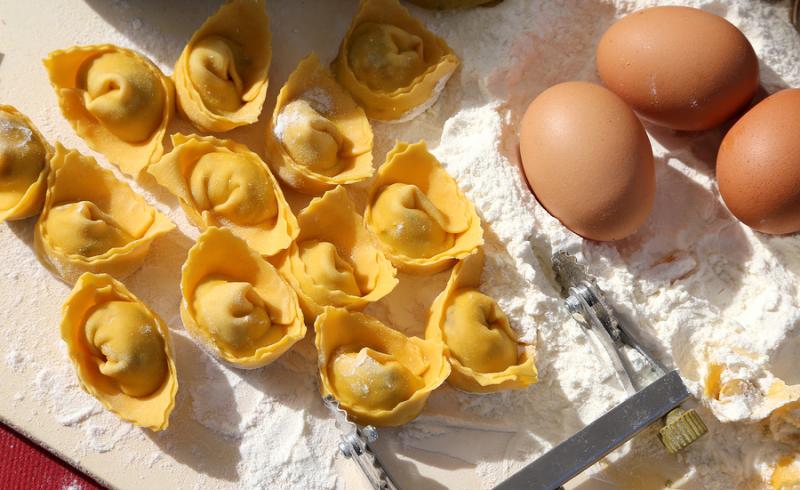Emilia-Romagna is considered the gastronomic capital of Italy, and for good reason: it’s the region that gave the world such prized products as Parmigiano Reggiano, Prosciutto di Parma and balsamic vinegar, among others.
Emilia-Romagna has 25 food and wine museums, each dedicated to one of its specialties or to the region’s gastronomic culture. Here are some of our favorites.
Gelato Museum Carpigiani – Anzola dell’Emilia (Bologna)
Just outside Bologna, in Anzola dell’Emilia is the Gelato Museum Carpigiani: 1,000 square meters dedicated to the history, culture, and technology of artisan gelato, in the same building that houses Carpigiani Gelato University, for aspiring professional gelato chefs.
The museum features an interactive itinerary highlighting three main themes: the evolution of gelato over time, the history of production technology, and the places and ways it is consumed. It includes original machines, multimedia presentations, historical images and documents, tools and accessories of the trade, and original video interviews.
End your visit at Carpigiani’s gelateria, where you can choose among several flavors, from classics to more inventive creations, all made on the premises.
https://www.gelatomuseum.com/en

Museo del Balsamico Tradizionale – Spilamberto (Modena)
Making balsamic vinegar is a labor of love and patience (it takes decades before it’s ready). Balsamic vinegar is made from cooked grape must, which ages in different wooden barrels, causing natural fermentation and progressive concentration, without adding any flavors or aromas.
In the process of making balsamic vinegar, nothing is left to chance, and the rituals and rules are revealed in the Museo del Balsamico Tradizionale, in the town of Spilamberto, located 10 km south of Modena, in the heart of balsamic vinegard production.
The museum includes a room featuring the objects and processing phases needed to obtain the prized condiment.
Consider taking one of the four guided tours offered daily at 10:45, 12:00, 14:00, 15:30.
https://museodelbalsamicotradizionale.org/

Enoteca Regionale Emilia-Romagna – Dozza (Bologna)
In the basement of a 13th-century fortress – the Rocca Sforzesca - in the village of Dozza, 35 minutes from Bologna, is the Enoteca Regionale Emilia-Romagna, home to the many wine varieties produced in the region of Emilia-Romagna, from Pignoletto to Lambrusco, from Sangiovese di Romagna to Malvasia , and more.
More than 200 regional wine producers are on display through their wines, and you can ask the Enoteca staff to guide you among the many wines on offer. Every Saturday afternoon, the Enoteca hosts a local producer with free tastings of their wines. In the summer, the Enoteca hosts a weekly evening event dedicated to a wine from the region, with tastings guided by a sommelier.
https://www.enotecaemiliaromagna.it/en/

Casa Artusi – Forlimpopoli (Forlì-Cesena)
Named after Pellegrino Artusi, author of the seminal cookbook “La scienza in cucina e l'arte di mangiar bene” (“Science in the Kitchen and the Art of Eating Well”), Casa Artusi is a museum-gastronomic center dedicated to Italian home cooking.
Located in an ancient, restored convent, within the complex of the Chiesa dei Servi, it features a library, restaurant, cookery school, wine cellar, bookshop and museum, focusing on different aspects of gastronomic culture, and on the regional cuisine.
Take a cooking class, because, as Artusi said, “The best teacher is practice,” or eat a meal in the restaurant, where you can try many of Artusi’s dishes, which vary according to the season, as well as fresh, home-made pasta and recipes from the tradition of Emilia-Romagna, everything served in the spirit of home cooking.

Museo del Sale – Cervia (Ravenna)
“An entire city in a grain of salt: a world of men and sea, sun and wind.” The salt made in Cervia, a major seaside resort of the Riviera Romagnola on the Adriatic Coast, a Slow Food presidium, is particularly prized because of its sweetness: it lacks the bitter aftertaste typical of salt, due to a combination of climate and processing.
The tradition of salt-making in Cervia goes back a long time, to the ancient Romans, and the Museo del Sale includes an open-air section where you can watch the ‘salinari’ at work, while inside the museum, located in the salt warehouse, you can learn about local history, the objects and tools used for production, salt trade, and more. The museum is managed by salt workers, who therefore are able to provide real insights into this local heritage.
Guided visits in English are offered throughout the summer.






